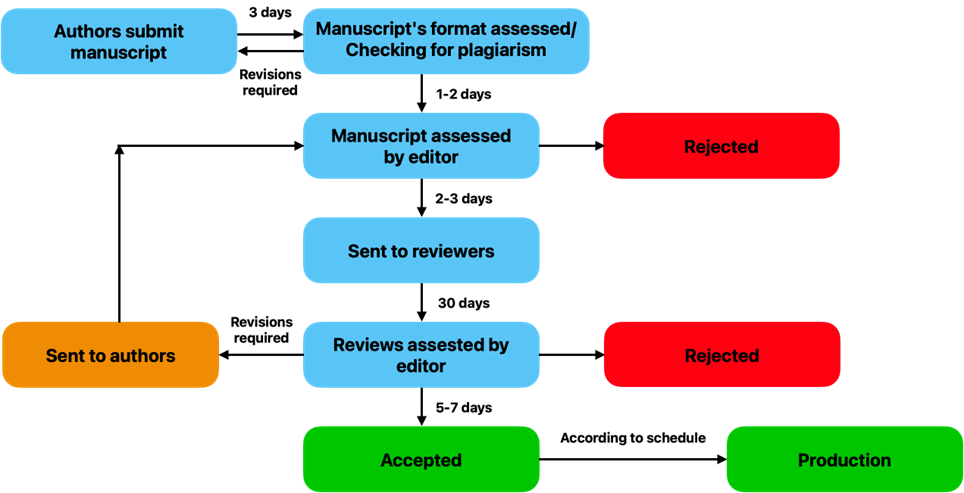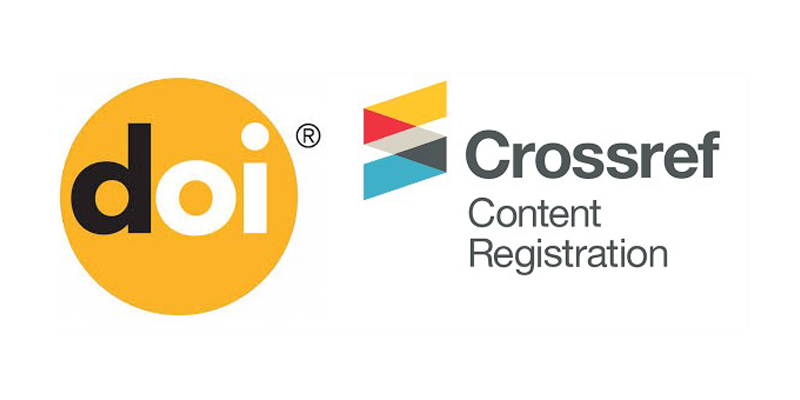Article consideration procedure
Manuscripts are accepted continuously throughout the year. The figure shows the chronology of manuscript processing.
- The principal author (corresponding author) registers on the journal's electronic portal, uploads materials in the form of two files, one of which should not contain information about the authors (full name, place of work, information about the authors). The manuscript sent by the author is sent to the journal's editorial board. The technical secretary checks the manuscript to ensure compliance with the technical requirements according to the template (Appendix 1). The author sends to the editorial board of the journal, along with the manuscript, a cover letter about the independent nature of the submitted manuscript, consent to check the article for plagiarism, inclusion in various databases and information systems, including full-text versions in the event of publication and granting exclusive rights to the publisher.
- The technical secretary checks the manuscript for independent execution through a licensed automatic plagiarism check system (https://antiplagiat.enu.kz/). A complete electronic report on the check is downloaded based on the automatic plagiarism check results. Articles that do not receive a satisfactory result (the threshold percentage of article originality is 70%) are not allowed for further consideration. Electronic reports on verifying the manuscript for plagiarism are not provided to the authors. Previously published articles, their translations into other languages (Kazakh, Russian, English, etc.), and articles submitted for review in different journals (publications) are not accepted for consideration. The technical secretary notifies the primary author/author for correspondence about this. If the article is rejected, the editors reserve the right not to discuss the reasons for the rejection.
The technical secretary sends the article, which has passed the required threshold of originality, to the editor-in-chief (responsible editor for the subject area). The editor-in-chief (responsible editor for the subject area) reviews the article to ensure compliance with the journal's subject area. In case of non-compliance, the journal's editorial board sends the author an e-mail with the justification for refusing publication.
- The editor-in-chief (the editor-in-chief for the subject area) determines two reviewers (a scientist or specialist in the relevant subject for each article) that have passed the initial selection. This procedure is carried out using the OJS (Open Journal System).
- The technical secretary sends the manuscript to the reviewer along with a full plagiarism check report to determine whether the article can be published in the journal.
- The journal uses a double (blind) peer review procedure: the editors do not disclose the names of reviewers and authors. Within 30 working days from the moment of receiving the article, the reviewer provides the editors of the journal with a reasoned review of the article, including an assessment of the relevance of the topic under study, the author's contribution to the scientific field, and the theoretical and practical significance of the results obtained. All reviews contain a recommendation for the publication of the article (with or without revisions) or its rejection. All reviews are submitted to the journal editors.
If a review is received for revision, the author must provide a corrected article version as soon as possible. Revision of the article should not take more than two weeks from the moment an e-mail is sent to the authors about the need to make changes. In response to the reviewer's comments, the author must provide (1) an edited file of the article in which all corrections are noted and (2) a substantiated response to the reviewer for each comment. The edited version of the article and the authors' response are sent to the reviewer for reconsideration. This process is repeated until the reviewer decides on the article. In case of agreement with the reviewer's comments but an unfair approach to their correction (after the third submission of the manuscript without eliminating the comments), the manuscript is rejected. In case of disagreement with the reviewer's comments, the author/authors send a letter with a justification to the journal's editor-in-chief. After reviewing the author/authors' appeal, the editor-in-chief decides to revise/reject the article.
If the authors do not return the revised version within two weeks from the date of sending the review, even in the absence of information from the authors refusing to revise the article. In that case, the editors can remove it from the register. In such situations, the authors are sent a corresponding notification about the manuscript being removed from the register due to the expiration of the period allotted for revision. All reviews and the editorial board's decision on the article are sent to the primary author (or corresponding author) specified in the metadata when submitting the article. All materials on the article (the final version, reviews, plagiarism report, and other documents, if any) are submitted for consideration at an editorial board meeting. The editorial board decides on the possibility of publishing the article in the journal based on the reviewers' opinions. The executive secretary keeps the minutes of the meetings. Articles that have received a negative review and are rejected by the editorial board are not considered. In case of controversial issues, the journal's editor-in-chief makes the final decision on articles.
- Publication is carried out in the general queue as the material is ready. The editors can form a queue based on the prepared issues' headings.
- After determining the issue's content, the responsible secretary will proofread the article texts (Kazakh, Russian, English languages), layout, and journal circulation.
- Note that the the list of submission files must include:
1) A manuscript file (docx) named as “First author surname_manuscript”; example “Yerkinov_manuscript”.
2) A manuscript file (docx) named as “First author surname_manuscript unnamed” (please remove all the data that can be used to identify authors); example “Yerkinov_unnamed manuscript”.
3) A cover letter.
A timeline for manuscript processing








